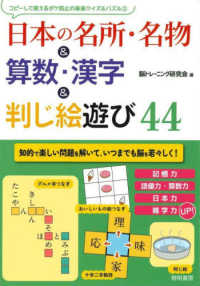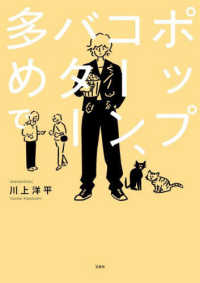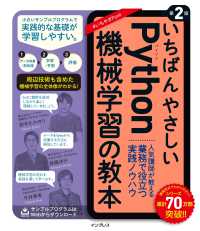- ホーム
- > 洋書
- > 英文書
- > Cinema / Film
Full Description
This book highlights the significant role that production artists played when Russian cinema was still in its infancy. It uncovers Russian cinema's connections with other art forms, examining how production artists drew on both aesthetic traditions and modernist experiments in architecture, painting and theatre as they explored the new medium of cinema and its potential to engender new models of perception and forms of audience engagement.
Drawing on set design sketches, archival documents and film-makers' memoirs, Eleanor Rees reveals how less-canonical films such as Behind the Screen (Kulisy ekrana, 1919) and Palace and Fortress (Dvorets i krepost', 1923), were remarkable from a design perspective, and also provides new readings of well-known films, such as Children of the Age (Deti veka, 1915) and Strike (Stachka, 1925). Rees brings to light information on significant but understudied figures such as Vladimir Egorov and Sergei Kozlovskii, and highlights the involvement of well-known figures such as Lev Kuleshov and Aleksandr Rodchenko.
Unlike the majority of late Imperial directors and camera operators, many early-Russian production artists continued to work in cinema in the Soviet era and to draw on practices forged before the 1917 Revolution. In spanning the entire silent era, this book highlights the often overlooked continuities between the late-Imperial and early-Soviet periods of cinema, thus questioning traditional historical periodisations.
Contents
Introduction
1. The Early-Russian Production Artist: Design, Creativity and Technology
I. Professional Backgrounds and Artistic Training
II. Collaborative Partnerships and Studio Practices
III. Roles and Responsibilities: From the Film Decorator to the Film Architect
2. The Rural Provinces
I. The Russian Landscape and the Search for a Native Cinema
II. Ethnographic Authenticity in late-Imperial Cinema
III. Transforming the Rural Environment: The Enchantment of Infrastructure and Technology in early Soviet Cinema
3. The Domestic Interior
I. The House as Entrapment: The Domestic Interiors of Boris Mikhin and Evgenii Bauer
II. The House as Ornament: Objects and the Desiring Gaze in late-Imperial Cinema
III. The House as Shelter: Material and Psychological Comfort in 1920s Soviet Cinema
4. The Workplace
I. The Private Study in Evgenii Bauer's Films: Individual Desire and Power Relations
II. Fantasy and the Everyday Reality of Labour: Aelita (1924) and The Overcoat (1926)
III. Cinematic Expressivity and Pleasure in the Industrial Workplace, from Engineer Prait's Project
(1918) to Golden Mountains (1931)
5. In the Studio and on the Stage
I. The Painter's Atelier
II. Cinema Studios and Auditoriums
III. The Circus Arena
Conclusion
Selected Bibliography
Filmography
Appendix





![DARKNESS, CENSURE ET CINEMA (3. POLITIQUE & RELIGION) [CARTONNE] (DARKNESS)](../images/goods/../parts/goods-list/no-phooto.jpg)


